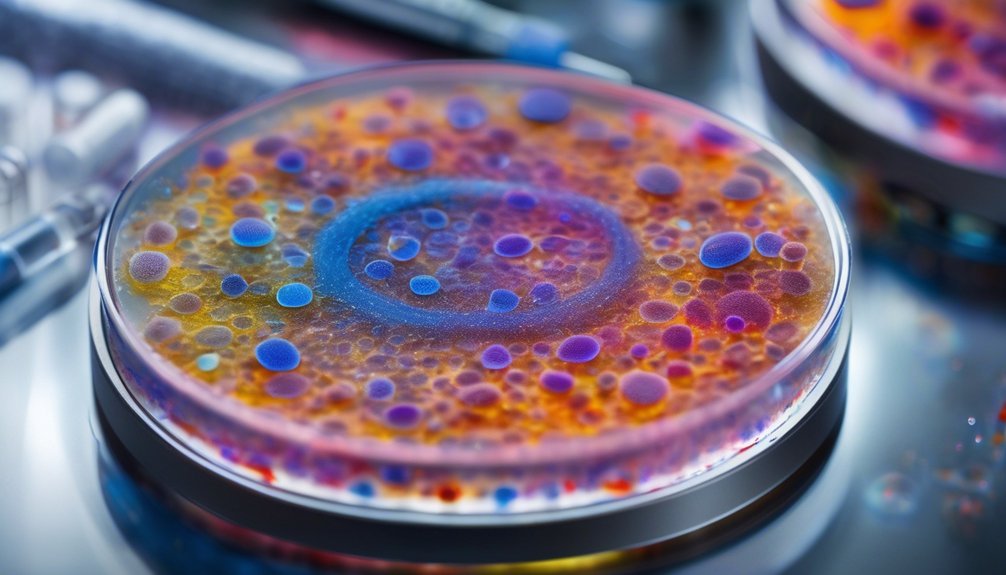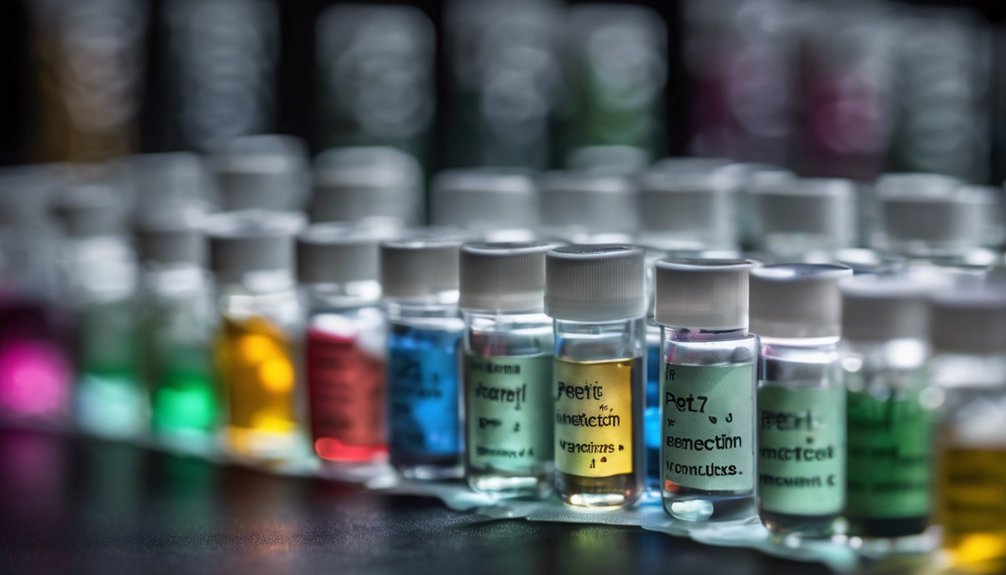Ivermectin has gained traction in the oncology field, with preclinical studies highlighting its potential to inhibit tumor growth and enhance chemotherapy effects. Research indicates it may reduce cell proliferation and increase apoptosis across various cancer types. However, significant variability in study designs raises questions about its true efficacy. As you navigate this complex landscape, consider what these findings might mean for the future of cancer treatment.
Key Takeaways
- Ivermectin shows potential in inhibiting tumor growth and enhancing chemotherapy efficacy through unique mechanisms of action in various cancer types.
- Preclinical studies indicate ivermectin reduces cell proliferation, increases apoptosis rates, and inhibits cell migration and blood vessel formation in specific cancers.
- Limitations in current research include variability in methodologies, small sample sizes, and lack of standardized dosing regimens, necessitating rigorous trials.
- Ivermectin’s efficacy as a standalone cancer treatment is still under investigation, with established therapies currently offering more proven outcomes.
- Future research should explore molecular mechanisms of ivermectin in cancer and design structured clinical trials to assess its efficacy and safety.
Understanding Ivermectin: Mechanism of Action

Although Ivermectin is primarily known for its antiparasitic properties, its mechanism of action extends beyond that realm, making it a subject of interest in cancer research.
You’ll find that Ivermectin acts on multiple cellular pathways, including the inhibition of certain ATP-binding cassette transporters, which can enhance drug absorption and potentially minimize drug interactions. This characteristic allows for therapeutic synergy when combined with other anticancer agents, thereby improving treatment efficacy.
Researchers have noted Ivermectin’s ability to induce apoptosis in cancer cells, further highlighting its potential role in oncology.
As you explore this complex interplay, consider how Ivermectin’s diverse mechanisms might contribute to innovative cancer therapies, ultimately serving to improve patient outcomes and expand treatment options.
The Historical Context of Ivermectin in Medicine
Ivermectin’s journey in medicine began in the late 20th century when it emerged as a groundbreaking treatment for parasitic infections. Developed from the fermentation products of the soil bacterium Streptomyces avermitilis, ivermectin quickly marked a series of medical milestones.
Its efficacy against river blindness and lymphatic filariasis transformed public health, particularly in tropical regions affected by these debilitating diseases.
As you explore ivermectin’s history, it’s clear that its introduction not only alleviated suffering but also demonstrated the potential of biotechnological advancements in medicine.
This drug’s impact is a testament to the importance of research and innovation, paving the way for further exploration of ivermectin’s applications in other medical fields, including oncology, which will be discussed later.
Recent Interest in Ivermectin for Oncology
As researchers delve deeper into the potential of existing drugs, recent interest in ivermectin for oncology has sparked considerable discussion. This attention stems from emerging evidence suggesting that ivermectin applications may extend beyond its traditional uses.
In cancer research, studies indicate that ivermectin could inhibit tumor growth and enhance the efficacy of certain chemotherapy agents. Its unique mechanisms of action—such as inducing apoptosis in cancer cells—present promising avenues for therapeutic exploration.
While preclinical findings are encouraging, it’s crucial to approach these developments with caution. Ongoing investigations will clarify how ivermectin might be integrated into oncology treatment regimens, emphasizing the need for rigorous clinical trials to evaluate its safety and effectiveness in cancer care.
Overview of Preclinical Studies on Ivermectin and Cancer

Emerging preclinical studies highlight the potential of ivermectin in cancer treatment, showcasing its ability to target various tumor types. Researchers have begun to explore ivermectin’s safety profile alongside its therapeutic effects, presenting promising avenues in cancer research. Below is a summary of key findings from these studies:
| Study Focus | Tumor Type | Findings |
|---|---|---|
| Cell Proliferation | Lung Cancer | Reduced cell growth in vitro |
| Apoptosis Induction | Breast Cancer | Increased apoptosis rates |
| Migration Inhibition | Colon Cancer | Decreased cell migration |
| Angiogenesis | Pancreatic Cancer | Inhibited blood vessel formation |
| Drug Synergy | Multiple Cancers | Enhanced effects when combined with other agents |
This growing body of evidence warrants further investigation into ivermectin’s role in oncology.
Ivermectin’s Effects on Different Cancer Cell Lines
While numerous studies have examined the effects of various compounds on cancer cell lines, recent research into ivermectin reveals its distinct impact across a range of tumor types.
You’ll find that ivermectin demonstrates notable cell line specificity, meaning its effectiveness varies depending on the cancer type. For instance, studies indicate that ivermectin can induce apoptosis in melanoma and breast cancer cells, while exhibiting less potency against others.
Furthermore, when combined with conventional treatments, ivermectin shows potential for treatment synergy, enhancing the overall therapeutic effect. This suggests that, in certain contexts, ivermectin could be a valuable adjunct to existing cancer therapies, paving the way for more targeted and effective treatment strategies that ultimately serve patients better.
The Role of Dosage and Administration in Research
Understanding the role of dosage and administration in research is crucial for evaluating ivermectin’s therapeutic potential in cancer treatment. Variations in dosage can significantly influence the drug’s efficacy and safety profile.
Different cancer cell lines may respond differently to specific doses, highlighting the importance of tailored dosing strategies. Additionally, the administration routes—whether oral, intramuscular, or intravenous—affect bioavailability and therapeutic outcomes.
For instance, some studies suggest that intravenous administration may enhance the drug’s efficacy compared to oral routes. Establishing optimal dosage and administration methods is essential for translating preclinical findings into effective clinical applications, ultimately serving patients better.
Careful consideration of these factors ensures that research findings contribute meaningfully to cancer treatment strategies involving ivermectin.
Potential Mechanisms Behind Ivermectin’s Anticancer Effects

Research into the potential mechanisms behind ivermectin’s anticancer effects reveals several intriguing pathways that could contribute to its therapeutic efficacy.
Studies indicate that ivermectin may disrupt key mechanistic pathways involved in cancer cell proliferation and survival. For instance, it appears to inhibit the activity of certain proteins that support tumor growth.
Furthermore, ivermectin influences cellular interactions, enhancing apoptotic processes and potentially reducing tumor cell migration. These effects can lead to a more favorable tumor microenvironment, promoting the immune system’s ability to target cancer cells.
Collectively, these insights suggest that ivermectin’s multifaceted actions might offer a promising adjunct in cancer therapy, warranting further exploration to fully understand its potential benefits in clinical settings.
Limitations of Current Preclinical Research
Although significant findings have emerged regarding ivermectin’s anticancer properties, several limitations in current preclinical research hinder a comprehensive understanding of its efficacy.
One major issue is research biases that can skew results, leading to overestimation of ivermectin’s benefits. Additionally, study variability, such as differences in methodologies and model organisms, complicates the ability to draw consistent conclusions.
Research biases and variability in methodologies hinder consistent conclusions about ivermectin’s anticancer benefits.
Many studies often lack standardized dosing regimens, which can further affect outcomes. Moreover, limited sample sizes may not adequately represent broader populations.
These factors contribute to a fragmented view of ivermectin’s potential as an anticancer agent, making it essential to approach findings with caution and to advocate for more rigorous, standardized research to better inform clinical applications.
Comparing Ivermectin With Conventional Cancer Treatments
As you explore treatment options for cancer, comparing ivermectin with conventional therapies reveals important distinctions in efficacy and mechanism. Ivermectin’s efficacy in oncological applications is still under investigation, raising questions about its viability as a standalone treatment. Conventional therapies, such as chemotherapy and radiation, have established efficacy but often come with significant side effects and variability in patient outcomes.
| Treatment Type | Key Characteristics |
|---|---|
| Ivermectin | Emerging research, dosage variations, limited data |
| Chemotherapy | Established efficacy, severe side effects, extensive research |
| Radiation Therapy | Targeted approach, localized side effects, proven outcomes |
| Immunotherapy | Personalized treatment, variable effectiveness, emerging research |
| Targeted Therapy | Specificity, generally fewer side effects, clinical validation |
Consider these aspects carefully when evaluating treatment options for cancer.
Future Directions for Research on Ivermectin and Cancer

While the current understanding of ivermectin’s role in cancer treatment is limited, future research is crucial for uncovering its potential therapeutic applications. Investigating ivermectin’s mechanisms at the molecular level could reveal pathways that may be exploited for cancer therapy.
You should consider the design of well-structured clinical trials to assess its efficacy and safety in cancer patients. By comparing ivermectin with existing treatment options, researchers can identify synergistic effects that enhance therapeutic outcomes.
Additionally, focusing on specific cancer types and patient demographics will help tailor treatments and maximize benefits. Collaborations between oncologists, pharmacologists, and researchers are essential for advancing this field and ensuring that any promising findings translate into practical solutions for patient care.
Implications for Clinical Use and Patient Care
The exploration of ivermectin’s potential in cancer treatment brings with it important implications for clinical use and patient care.
As you consider integrating ivermectin into treatment protocols, it’s crucial to adhere to established clinical guidelines to ensure patient safety. Current research highlights ivermectin’s promising effects, but translating these findings into practice requires caution.
You must assess the individual patient’s health status, potential drug interactions, and the current body of evidence. Engage in open dialogues with patients about the risks and benefits, making informed decisions together.
Continuous monitoring of patient outcomes will be essential as more data emerges. Ultimately, your commitment to evidence-based practices will help optimize care while prioritizing the well-being of those you serve.
Frequently Asked Questions
Is Ivermectin Safe for All Cancer Patients?
Imagine a 60-year-old patient with a specific cancer type. Ivermectin’s safety varies based on patient demographics and dosage. Always consult healthcare professionals to assess individual risks and benefits before considering it for cancer treatment.
Can Ivermectin Be Used Alongside Traditional Cancer Therapies?
You can explore using ivermectin alongside traditional cancer therapies, as some studies suggest potential treatment synergy. However, combining therapies requires careful evaluation of safety and effectiveness to ensure the best outcomes for patients.
What Are the Side Effects of Ivermectin in Cancer Treatment?
Imagine navigating a stormy sea; you must know Ivermectin’s potential toxicity. While it may complement treatments, it’s essential to follow treatment guidelines, as side effects can include nausea, dizziness, and allergic reactions. Stay informed.
How Long Does Ivermectin Take to Show Effects on Cancer?
Ivermectin’s effects on cancer may vary, but studies indicate it could take days to weeks for noticeable changes in cancer cell responsiveness, depending on the specific mechanisms involved and individual patient factors.
Are There Specific Cancer Types That Respond Better to Ivermectin?
Research shows varying ivermectin efficacy across different cancer cell lines. Certain types, like melanoma and leukemia, tend to respond more favorably. Understanding these distinctions can enhance treatment strategies and improve patient outcomes in clinical settings.
Conclusion
In summary, while ivermectin shows significant promise in preclinical cancer research, persistent problems persist. Preliminary results suggest it can potentially play a pivotal role in tumor treatment, but the patchwork of studies highlights the need for more precise, protocol-driven trials. As we seek to understand its full potential, careful consideration of its combination with conventional therapies might pave the path for practical applications in patient care. Future findings could transform treatment paradigms, but caution is crucial.




